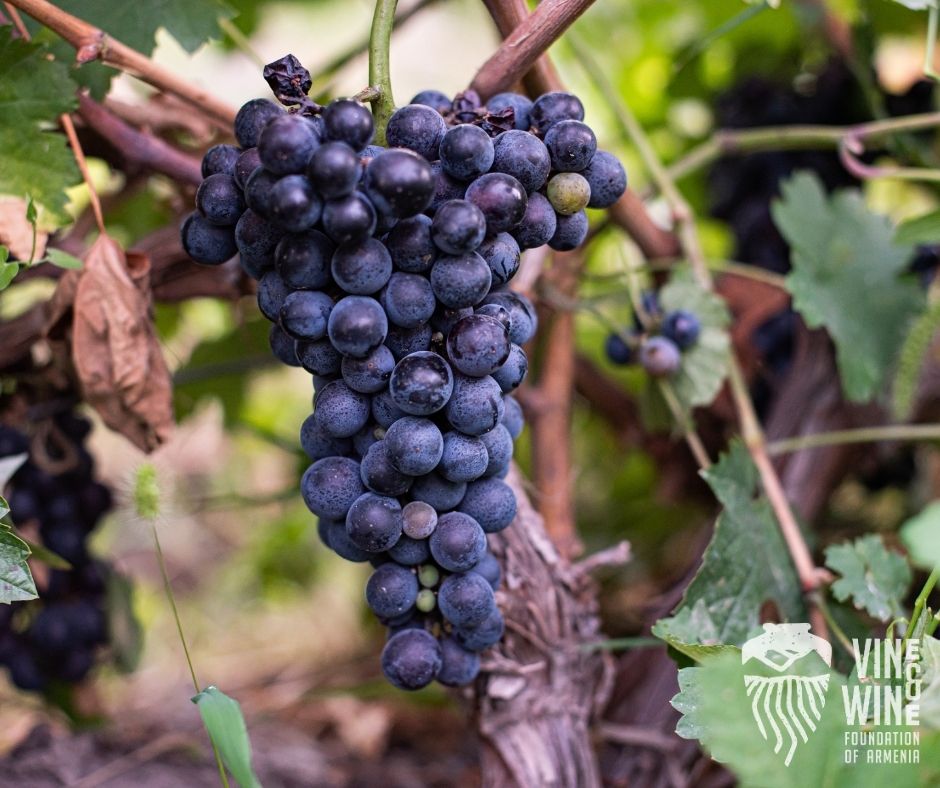Kakhet
Ampelographic characteristics:
 Sugar content: 23-24%, the same time keeping high acidity.
Sugar content: 23-24%, the same time keeping high acidity.
 Middle-height plants, leaves are medium-sized, rounded, five lobed, pubescent cobweb below. Colour of the leaves in autumn is red. Bunches are medium, sometimes large with a medium density of berries. Berries are medium-sized, round, dark blue coloured, almost black, sometimes with a dark red hue. Skin is thick and covered with a wax layer. The pulp is thick and juicy.
Middle-height plants, leaves are medium-sized, rounded, five lobed, pubescent cobweb below. Colour of the leaves in autumn is red. Bunches are medium, sometimes large with a medium density of berries. Berries are medium-sized, round, dark blue coloured, almost black, sometimes with a dark red hue. Skin is thick and covered with a wax layer. The pulp is thick and juicy.

Synonyms:
Black Kakhet, Sev Milaga
Resistance to diseases:
 Much damage can be caused by mildew and lightly damaged by oidium.
Much damage can be caused by mildew and lightly damaged by oidium.
Vegetative features:
 The grape is late ripening. The variety reaches its technical maturity in the end of September (the sum of active temperatures 4000 O C in 190-210 days) Fruit giving starts on the second year after planting, the first harvest has to be from 4-5 th year after planting. Yield – 17-20 t/ha
The grape is late ripening. The variety reaches its technical maturity in the end of September (the sum of active temperatures 4000 O C in 190-210 days) Fruit giving starts on the second year after planting, the first harvest has to be from 4-5 th year after planting. Yield – 17-20 t/ha
Climate conditions:
 Soil structure is clay-sandy. In the case of stony dry soil, the height is lower, but the yield is higher in quality. Poor frost resistance: wines are buries for winter. Kakhet loves humidity; however over humidity can slowen the maturation of berries.
Soil structure is clay-sandy. In the case of stony dry soil, the height is lower, but the yield is higher in quality. Poor frost resistance: wines are buries for winter. Kakhet loves humidity; however over humidity can slowen the maturation of berries.
 Wine characteristics:
Wine characteristics:
Kakhet is used in mono-varietal wine production, as well as in blend with Areni,
Haghtanak and other red varieties. It is mainly used for the production of table wine, dessert
wine and fortified wine; as well as Kakhet is used in the preparation of wine material for brandy,
and grape juice.
The real Kakhet is distinguished with dark, concentrated colour, delicate aromas of
flowers, forest berries, and long, tannic aftertaste.
At high levels of sugar, Kakhet maintains significant acidity.
The accumulation of sugar is quite intense, at the same time, the acidity changes little,
making it possible to produce high-quality wines for long-term ageing.
 Historic notes:
Historic notes:
Kakhet is an indigenous Armenian grape variety which, with its morphological
characteristics and biological properties, belongs to eco-geographical variety group of the Black
Sea basin. It originates from the ancient Armenian land – Urmia. It had been actively cultivated
for 50-60 years also in Armenian SSR times. Today Kakhet is widely expended in Ararat Valley.
The variety gave the wrong impression that it was brought from Kakheti, however, neither in
Kakheti nor in other winemaking regions of Georgia this variety was found.
By 1940s the total surface of Kakhet vineyards reached 3490 ha: including Ehcmiatsin
with 2780 ha, Vedi with 381 ha, Hoktemberian with 90 ha, and Kotayk with 40 ha.
The name of this variety (“kakhet” translated from Armenian means “hanging”) is due to
the large and heavy bunches that were hung to save the vine from breaking. Despite this, there
was a tradition in Armenia: grapes for storage were suspended in trenches or horizontal poles,
and the grapes would stay there for several months.

